Etruscan Warfare › Etruscan Trade » Ancient origins
Articles and Definitions › Contents
- Etruscan Warfare › Ancient History
- Etruscan Trade › Antique Origins
Ancient civilizations › Historical and archaeological sites
Etruscan Warfare › Ancient History
Definition and Origins
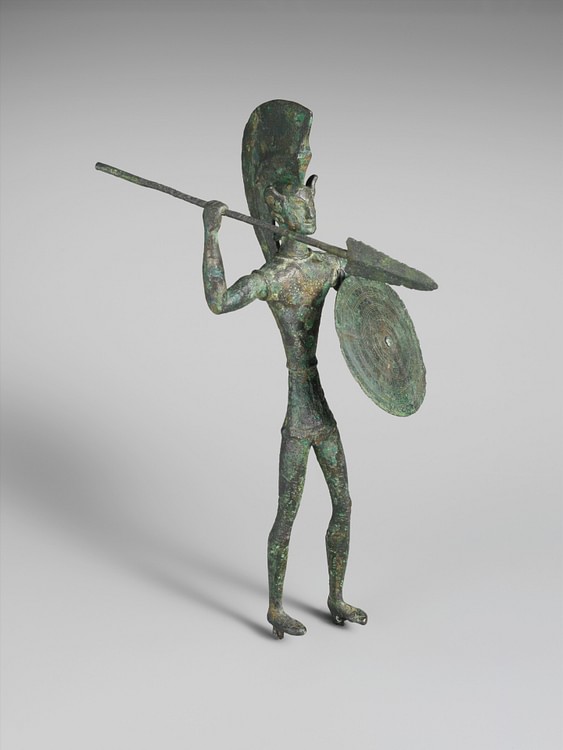
The Etruscan civilization, which flourished in central Italy from the 8th to 3rd century BCE, gained a reputation in antiquity for being party-loving pushovers when it came to warfare, but the reality is somewhat different. History being most often written by the victors, the Etruscans were conquered by and assimilated into the Romans' fast-growing empire, and Latin authors minimised the debt they owed to Italy's first great civilization and the difficulties they had in establishing themselves as top dog in the region. Without extensive written texts of their own, the history of the Etruscans must be pieced together from what little remains of their culture, namely, the ruins of fortification walls, surviving weapons, armour, and artworks depicting warfare-related themes, and secondhand accounts of ancient writers. Nevertheless, some features of Etruscan warfarebecome clear: the use of bronze armour, shields and swords, a preoccupation for defence shown in the building of fortification walls, and a general lack of unity between cities, which would, in the end, ring the death knell of the Etruscan culture.
WEAPONS & ARMOUR
Etruscan armies, like most Mediterranean fighting powers of the day, were drawn from the citizen body who were otherwise farmers when not at war. Soldiers paid for their own equipment and fought for their individual city-state to protect its and their own interests either to defend their territory or expand it, for control of trade routes on land and sea, and to acquire the resources they deemed necessary. From the 5th century BCE, evidence of paid soldiers and mercenaries is seen in the minting of coinage for that purpose.
CORINTHIAN HELMETS HAVE BEEN FOUND IN ETRUSCAN TOMBS, BUT THE MOST COMMON TYPE IS THE PLAIN BELL-SHAPE IN BRONZE WHICH HAS A NARROW BRIM.
Armour was of bronze and took the form of breastplates, greaves to protect the lower legs, helmet, and round shield, much like the hoplite of Greek warfare. It is likely that hardened leather was widely used as body armour too. Lighter and more effective than bronze, such perishable material would not have survived as bronze armour has done. The principal weapons were bronze spears and double-edged swords. A stele from Vetulonia depicts an Etruscan warrior carrying a double-axe, but this may have been a symbol of authority rather than a weapon. Both bronze armour and weapons of the Greek hoplite type have been found in multiple Etruscan tombs of the 8th and 7th century BCE at sites such as Cerveteri, Tarquinia, Veii, and Vetulonia. However, it is important to note here that some of these weapons, and helmets in particular, may have only had a symbolic ritual purpose and may not have actually been used in battle. An example is the famous bronze helmet of Veii with its huge and impractical bronze triangular crest. Corinthian helmets have also been found in tombs, but the most common type is the plain bell-shape in bronze which has a narrow brim and, in some cases, detachable cheek-guards.
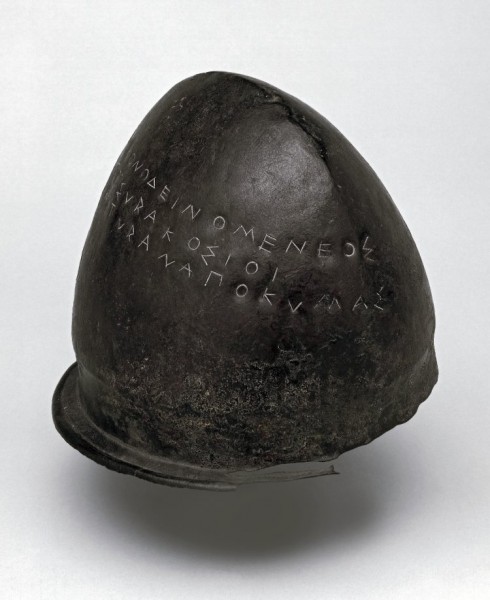
Etruscan Bronze Helmet
Another less than clear issue is the Etruscan use of horses in warfare. Tombs abound with bronze horse bits, and there are numerous bronze two-wheeled chariots interred with the dead. Just whether these were used in warfare or if they were merely a symbol of wealth or whether they were intended only to aid the deceased in their passage into the next life is a moot question.
ORGANISATION & TACTICS
As the historian N. Spivey makes clear, reconstructing the Etruscan military past has its difficulties:
The literary evidence is untrustworthy, and the iconographical evidence is to be treated with caution.Constructing Etruscan realities from depictions of warriors on either imported Greek and near-eastern artefacts is dangerous. (127)
Roman writers and Etruscan art demonstrate that Etruscan warriors, armed as they were like the hoplites of Greece, may also have adopted the Greek phalanx formation – a line of warriors moving forward as one on the battlefield with spears bristling and protecting each other with a solid barrier of bronze shields. Hoplite warfare was brief and brutal with the two sides clashing but had the advantage that the issue was often settled in one encounter.
SUCH TACTICS AS THE PHALANX MAY ONLY HAVE BEEN USED EARLY ON IN ETRUSCAN HISTORY WHEN BATTLES WERE BETWEEN RIVAL CITIES TO SETTLE DISPUTES IN A FORMULAIC SET-PIECE BATTLE.
However, such tactics as the phalanx may only have been used early on in Etruscan history when battles were between rival cities to settle disputes in a formulaic set-piece battle. The fact that most Etruscan helmets are of a simpler bronze bowl type would suggest that warfare was typically more dynamic, and greater visibility and mobility required that type of helmet. The greater protection but more restricted visibility of the Corinthian helmet is better suited to more static phalanx engagements, but they are in a minority when it comes to archaeological finds. Similarly, shields are generally smaller in the 5th century BCE as compared to the 6th century BCE.
FORTIFICATIONS & SEIGE WARFARE
Many Etruscan cities were protected by city walls. Not always entirely enclosing a city, they protected it from attack at its weakest points. Those sections not benefitting from a wall were usually protected by a natural precipice or man-made terraces and ditches. Portions of fortification walls survive at Cerveteri, Tarquinia, Veii, Vulci, and other cities. Made from either mud-bricks on top of stone plinths or entirely from tufa blocks, most date from the 5th century BCE. Many include well-built gates with their own towers. Such fortifications were designed to offer the community – both town and country dwellers – a temporary point of refuge in the case of attack. However, that walls could stand a prolonged attack is evidenced by the 10-year Roman siege of Veii between 406 and 396 BCE.
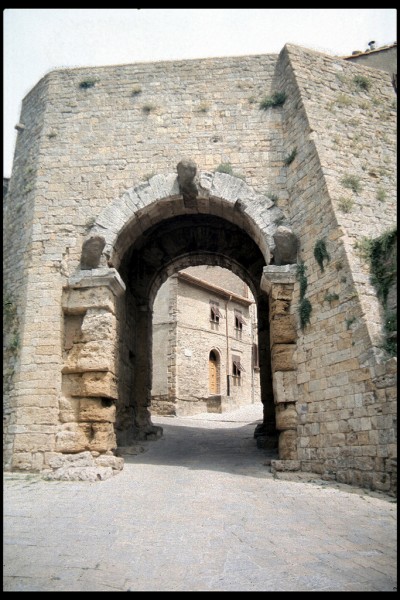
Porta all' Arco, Volterra
NAVAL WARFARE
If the history of Etruscan land warfare is rather patchy, then their naval exploits are positively threadbare in the historical record. With a plentiful supply of timber, the Etruscans were able to build large sailing ships which, under the power of oars in battle, could ram enemy ships to be then boarded by their compliment of foot soldiers if necessary. The importance to the Etruscan economy of maritime trade is attested by the depiction of ships in art, the presence of model ships in tombs, and the prodigious amount of foreign goods that found their way to Etruria.
That the Etruscans were able sailors and navigators is attested by Greek and Roman writers, even if only by the rather backhanded compliment of continuously referring to them collectively as Tyrrhenian pirates, such was their domination of the waters off the coast of western Italy. This ' piracy ' was more likely legitimate trade operations which the Greeks and Romans would dearly have loved for themselves. The legendary prowess of Etruscan seamen is further illustrated in the Greek myth that even the god Dionysos found himself captured by them and only managed to escape by changing the sailors into dolphins. Greek writers mention that the Etruscans managed to occupy parts of Sicily, Sardinia, Corsica, Samos, and southern France and Spain, even rivalling the great naval power of Carthage in the Mediterranean. The good times at sea came to an end, though, with the rise of Syracuse and defeat at the Battle of Cumae in 474 BCE.
ROMAN CONQUEST
The Etruscan armies of part-time soldiers, probably recruited on a basis of kinship or clan membership, proved to be no match for the more professional and tactically dynamic Roman army which was able to draw on greater resources of both men and equipment. Another disadvantage of the Etruscan cities was their failure to support each other against the common threat of Rome. Individual cities had in the past formed alliances to good effect, as seen in the defeat of a Phocaean fleet by a joint Cerveterian and Carthaginian force in 540 BCE, but the military weakness of the Etruscans was all too evident in the wave of attacks from Syracuse in the first quarter of the 4th century BCE when Etruscan coastal sites were sacked and their lucrative trade routes taken over by the Sicilians.
Etruria, or more correctly, the northern parts of Italy the Etruscans had colonised, was also attacked from the north by migrating Celts starting from the beginning of the 5th century BCE, a conflict which culminated in defeat at the Battle of Melpum (Milan) in 396 BCE. After six centuries, the Etruscan control of central Italy was suddenly under serious threat from two directions.

Battle Scene, Francois Tomb, Vulci
The Etruscan cities had long been rivals and frequently fought each other if tomb paintings of local wars such as those of the Francois Tomb at Vulci are taken as typical. Additional evidence of infighting between Etruscan cities is found at such sites as Acquarossa which were abandoned and the population absorbed into larger neighbouring towns. Further, as Rome encroached into Etruria moving ever northwards, the Etruscan cities failed to mobilise the Etruscan League and transform that body from a religious to a military organisation of mutual aid. The Romans still did not have everything their own way, though.The legendary king of Chiusi Lars Porsenna had attacked Rome in the final decade of the 6th century BCE, and the Etruscans proved a stubborn foe to conquer.
Battles, sieges, and the sacking of cities would rumble on for two centuries in a brutal fight for control of central Italy. Tarquinia famously sacrificed 307 Roman prisoners in their forum in 356 BCE, which brought a retaliation murder of 358 Tarquinian prisoners in Rome. The Etruscans formed an alliance with the Samnites, Umbrians, and Gauls to face Rome, but despite some initial successes, the Romans won a decisive victory at Sentinum in 295 BCE, and sieges of towns such as Chiusi, Perugia, and Troilum soon followed. Another Roman victory came in 283 BCE at the Battle of Lake Vadimo against an Etruscan- Gaul alliance.
In 281-280 BCE, more Roman victories against the likes of Tarquinia, Orvieto, and Vulci meant that most of Etruria finally fell under Roman control; colonies of veterans were established, and once great Etruscan towns were reduced to minor Roman settlements. One of the last Etruscan towns to fall was Cerveteri in 273 BCE whose lands were confiscated and redistributed.Through a mix of diplomacy, alliances, prolonged truces, and military prowess, the Romans had established themselves as the masters of Italy, the first step in their quest to control the Mediterranean and beyond.
Sadly for the Etruscans, this was not the end of the fighting. Etruscan armies sided with Rome in the Battle of Talamone against the Gauls in 225 BCE, and although the former Etruscan cities made the wise decision to stay loyal to Rome when Hannibal invaded Italy during the Second Punic War (218-201 BCE), many northern towns then unwisely sided with Mariusin the Roman civil war of the early 1st century BCE. The victor of that conflict – Sulla – then took brutal revenge, mercilessly sacking such cities as Chiusi, Populonia, and Vetulonia in 83 and 82 BCE. The Etruscans were finished as a warring nation, and even their very culture was fast disappearing into the new reality of a Roman world.
Etruscan Trade › Antique Origins
Ancient Civilizations
The Etruscan civilization flourished in central Italy between the 8th and 3rd century BCE, and their prosperity was largely based on their exploitation of local mineral resources, both through manufactured goods and trade. The Etruscans exchanged goods not only with their fellow cities in Etruria but also with contemporary Mediterranean civilizations such as the Greeks, Phoenicians, and Near East cultures. Especially noted for their production and export of iron, the Etruscans received in exchange, amongst other things, ivory from Egypt, amber from the Baltic, and pottery from Greece and Ionia. With these trade relations came cultural influences as seen in both Etruscan daily life and art.
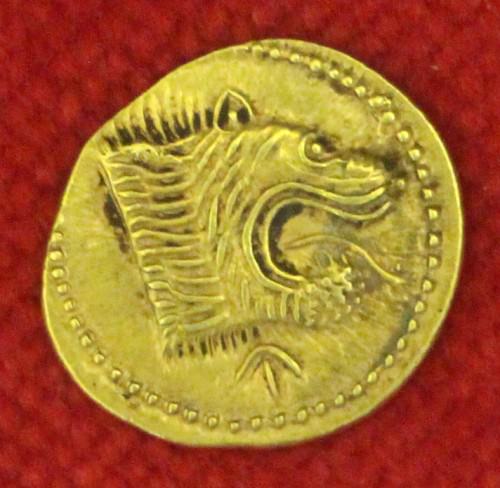
Etruscan Gold Coin
A NETWORK OF INDEPENDENT CITIES
It is perhaps important to note here that when speaking of Etruscan trade we are describing the trade arrangements of individual towns. The Etruscans did not form a cohesive political and economic state, as the historian N. Spivey explains,
It is clear that there was no administered trade at this stage; many small political units were competing on relatively equal terms in an exchange network. Access to this exchange network was restricted to a 'chiefly' elite but was not heavily centralised. (Spivey & Stoddart, 83)
Having said that, it is true that the Etruscan coastal towns generally acted as emporia, especially from the 7th century BCE onwards. From sites such as Cerveteri, Tarquinia, and Populonia goods would then have been traded on into the interior of Etruria. One can imagine that goods from inland sources would have travelled in the opposite direction.
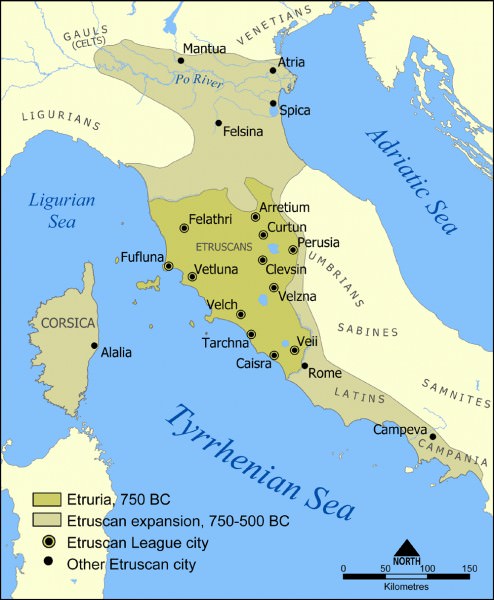
Etruscan Civilization
Goods would have been bartered and paid for in kind, although from the 6th century BCE there is evidence that bronze ingots stamped with a branch without leaves were used to pay for bulk orders. From the 5th century BCE, several Etruscan towns minted their own gold or silver coinage, although this was, as elsewhere in the Mediterranean, probably driven by a necessity to pay soldiers rather than for trade.
VILLANOVAN TRADE
Early Etruscan culture, known as the Iron Age Villanovan culture, developed between 1000 and 750 BCE in western central Italy. The initial prosperity of these peoples was based on rich mineral deposits in the area which included lead, tin, copper, silver, and most of all, iron. Agriculture developed with metal implements improving productivity, which brought a stability and the possibility of a small-scale manufacturing industry of pottery and metal goods. Thus, an exchange of goods took place between Etruscan towns, especially those on the coast and near rivers where access inland was made easier. In addition, bronze works discovered at Etruscan sites indicate contact with Sardinia, central Europe, the Balkans and even the Cyclades. These links brought about a more advanced metallurgy, but the flowering of Etruscan trade was only just beginning.
EVENTUALLY, THE MINERAL RESOURCES & THE INCREASED WEALTH OF THE ETRUSCANS BEGAN TO ATTRACT FOREIGNERS TO THE AREA.
EXPANDING HORIZONS
Eventually, the mineral resources and the increased wealth of the Etruscans began to attract foreigners to the area. In the 8th century BCE Euboeans, via their base at Pithecusae (Ischia), introduced themselves to the Etruscans. Also in the 8th century BCE, or even earlier, trade links were established with contemporary cultures in Egypt, Phoenicia, Ionia, and the Near East, all eager to find new metal sources. This is evidenced by finds of, for example, ostrich eggs (decorated in Etruria), ivory goods, glass paste jewellery, and metal objects distinctive to their place of production such as small bronze boats from Sardinia and scarabs from Egypt. Fine Greek pottery seems to have been especially esteemed by the Etruscans, and this came from workshops in Sparta, Corinth, Eastern Greece, and above all, Attica. There is also evidence that pottery wares were even made to suit Etruscan tastes. Foreign imports did not put a stop to local production as wares by the Micali painter of Vulciillustrate. His vessels have been found at sites across Etruria and show that local trade prospered alongside international exchange. Other foreign imports would have included gold, ivory, fine wooden furniture, glass bottles for perfumes and creams, oil lamps, and slaves.

Attic Black-figure Plate, Vulci
Such was the Etruscan maritime presence in this period that they gained a reputation for piracy which lasted throughout antiquity. The manufacturing industry, already booming thanks to a ready supply of raw materials, further benefitted from artists and craftsmen from Greece and the Levant coming in person to set up shop in Etruria, such was the demand for precious metal goods and fine pottery. Many of these foreign artists and traders established themselves in specialised coastal trading areas – emporia. Here they could live as they wished, protected by their sanctuaries and able to worship their religion, in effect, a home away from home. The most important of these emporia were Pyrgi (a port of Cerveteri), Regae (Vulci), and Gravisca (Tarquinia). Thus, the Etruscans were guaranteed a continuous supply of the luxury goods which they required for everyday use or as votive offerings at sanctuaries or for goods to be left to accompany the dead in the large painted tombs of the Etruscan elite over the centuries.
SUCCESSFUL EXPORTS
By the 6th century BCE, Etruscan grain, pine nuts, olive oil, and wine were being exported in large quantities. Chiusi produced fine stone sculpture and bronze cauldrons. Pisa was noted for its marble and wood suitable for shipbuilding, Cerveteri gained fame for its goldwork and distinctive two-handled pottery water vessels, Populonia was one of the Mediterranean's main producers of pig iron (smelting ore from Elba), Tarquinia had its linen production, Veii produced pottery and bronze horse bits, and Vulci had countless workshops where just about everything was produced from painted ostrich eggs to inlaid ivory plaques.
An increase in competition from Greek and Carthaginian traders, though, drove the Etruscans to look for new markets inland, and these they found in the Celts on the other side of the Alps. Wine exports are attested by the many finds there of the large bronze jugs made at Vulci. Amphorae made at Vulci carrying the local wine have been found right along the Etrurian coast and in Provence, Alicante, and on the islands of Sicily and Naxos.
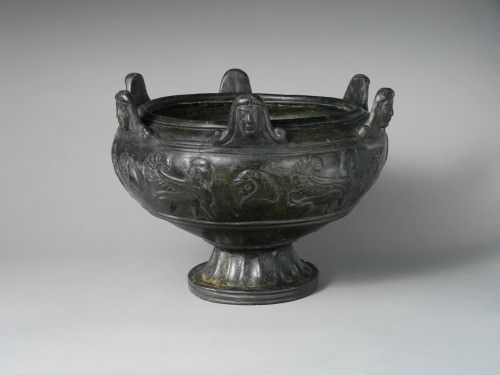
Bucchero Krater
Another successful Etruscan export was bucchero, their own distinctive pottery with a near-black glossy finish. Examples of bucchero have been found along the coastal areas of southern France and northwestern Spain, at Athens, Sparta, and Corinth, on Corfu and Cyprus, at Carthage, in Romania, Syria, Libya, and Egypt. That other Etruscan manufactured goods (horse bits, helmets, and shields) were appreciated by foreign cultures is seen in their use as votive offerings at such important 'international' religious sites as Olympia, Delphi, and Dodona. In addition, Italian-made fibulae (buckles) have been excavated on Aegina, Rhodes, and Samos.
COMPETITION FOR TRADE
Naturally, the Etruscans did not have everything their own way, and other trading cultures frequently sought to muscle in on their lucrative trade routes. Etruscan cities signed a treaty with Carthage to agree on exclusive areas of operation in 509 BCE, but the pair had to defend their interests against a Greek naval fleet. This they did with success at the Battle of Alalia (aka Battle of the Sardinian Sea) in 540 BCE. In the 5th century BCE, Syracuse was the dominant Mediterranean trading power, and the Sicilian city combined with Cumae to inflict a naval defeat on the Etruscans at the battle at Cumae in 474 BCE. Worse was to come when the Syracusan tyrant Dionysius I decided to attack the Etruscan coast in 384 BCE and destroy many of the Etruscan ports. By the late 4th century BCE Rome was beginning to flex its muscles in the region too, and these factors contributed significantly to the loss of trade and the consequent decline of many Etruscan cities seen from the 4th century BCE onwards.
LICENSE:
Article based on information obtained from these sources:with permission from the Website Ancient History Encyclopedia
Content is available under License Creative Commons: Attribution-NonCommercial-ShareAlike 3.0 Unported. CC-BY-NC-SA License